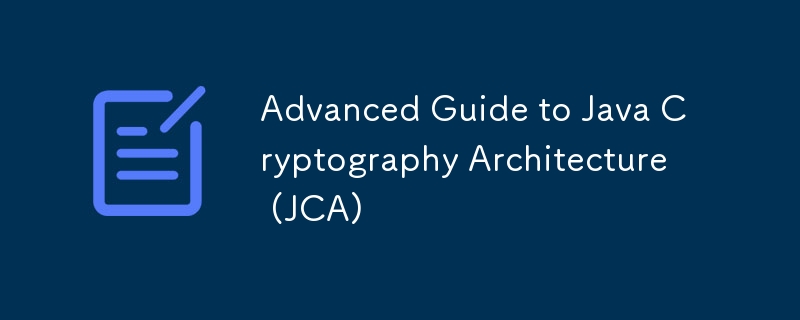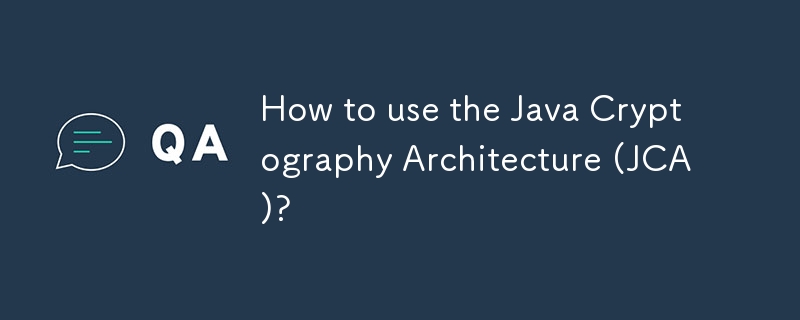Found a total of 10000 related content

Advanced Guide to Java Cryptography Architecture (JCA)
Article Introduction:JavaCryptographyArchitecture (JCA) is a flexible and powerful framework for providing encryption services for Java applications; it builds a modular architecture through Provider, Service and EngineClasses, supporting encryption, decryption, digital signature, message digest, key generation and secure random number generation; 1. Use Security.getProviders() to view installed providers, and give priority to standard providers such as SUN, SunJCE or BouncyCastle; 2. Generate symmetric keys through KeyGenerator (such as AES-256, and ensure that JCE does not have any
2025-07-25
comment 0
849

Lithe Crypt: Simplifying Cryptography in PHP Applications
Article Introduction:Lithe Crypt is a simple PHP encryption and decryption utility designed to work with the Lithe framework. It uses the AES-256-CBC algorithm for secure data handling.
Installation
To install the Lith package
2024-11-05
comment 0
549

Lithe Crypt: Simplifying Encryption in PHP Applications
Article Introduction:Lithe Crypt is a simple encryption and decryption utility for PHP, designed to work with the Lithe framework. It utilizes the AES-256-CBC algorithm for secure data handling.
Installation
To install the Lithe Crypt package, you can use Com
2024-11-07
comment 0
681


How to use OpenSSL command line on Debian
Article Introduction:The OpenSSL command line tool under the Debian system is powerful and can be used for various tasks such as key pair generation, certificate creation and management, data encryption and decryption. This article will guide you to quickly get started with OpenSSL. 1. OpenSSL installation First, confirm that your Debian system has OpenSSL installed. If not installed, please execute the following command: sudoaptupdatesudoaptininstallopenssl 2. Key pair generation 1. Generate RSA private key: opensslgenrsa-outprivate.key2048 This command generates a 2048-bit RSA private key and saves it to private.k
2025-04-13
comment 0
561

How to use the Java Cryptography Architecture (JCA)?
Article Introduction:How to implement security features using JavaCryptographyArchitecture (JCA)? The answers are as follows: 1. Select the appropriate provider, such as the built-in SUN, SunJCE or third-party BouncyCastle (BC), and add Security.addProvider() according to the needs; 2. Use KeyPairGenerator to generate key pairs, such as RSA or EC algorithm; 3. Use Cipher class to perform encryption and decryption operations, pay attention to choosing the appropriate filling method; 4. Use MessageDigest to implement message digest, such as SHA-256 for data integrity verification; 5. Use KeySto
2025-07-10
comment 0
696

PHP Master | Working with Slim Middleware
Article Introduction:Slim Framework Middleware: Building Powerful PHP Micro Applications
Slim is a powerful PHP mini framework, where middleware features allow implementation of various filter-style services such as authentication and caching in applications. Middleware encapsulates applications and can affect the application's environment as well as request and response objects.
Key points:
Slim's middleware is a powerful feature that allows the implementation of various filter-style services such as authentication and caching. Middleware encapsulates applications and can affect the application's environment, request and response objects.
To implement middleware in Slim, you need to write a class that extends the SlimMiddleware class and overrides the call() method. This method is
2025-02-24
comment 0
616

Memory Performance Boosts with Generators and Nikic/Iter
Article Introduction:PHP iterator and generator: a powerful tool for efficient processing of large data sets
Arrays and iterations are the cornerstone of any application. As we get new tools, the way we use arrays should also improve.
For example, a generator is a new tool. At first we only have arrays, and then we gain the ability to define our own class array structure (called iterators). But since PHP 5.5, we can quickly create class iterator structures called generators.
Generators look like functions, but we can use them as iterators. They provide us with a simple syntax for creating essentially interruptible, repeatable functions. They are amazing!
We will look at several areas where generators can be used and explore the need to note when using generators
2025-02-16
comment 0
504



















